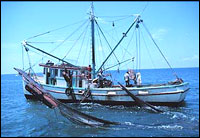Dear Umbra,
I recently turned 40 and have decided I need to pay more attention to what I eat on a daily basis. My diet has never been horrible, and I’ve always believed in all things in moderation, but a persistently elevated cholesterol level and my mortality now a smudge on the horizon have helped nudge me in this direction. And everywhere I turn it’s fish, fish, and more fish: doctors recommending more omega-3 oils (in the form of fish-oil pills), Oprah lending her support to a heart-healthy diet full of salmon, and on and on. Not to mention that I love seafood.
But I also know that the world’s oceans and its fisheries are in deep trouble, and I’m troubled about the choice between consuming farm-raised or wild fish. Are there some fish stocks from certain regions of the world that are managed properly and sustainably? And are there certain fishing techniques that are more green? I often see restaurants advertising line-caught salmon and have wondered if this is better than using nets.
Jeryl
Seattle, Wash.
Dearest Jeryl,
Happy belated birthday! May you celebrate many more over yummy fish dinners.

Fishing for answers.
Photo: NMFS.
Most of our food was tamed years ago, but fish still roam wild in the depths of the oceans, doing their best to escape our clutches. It’s getting toward the last stand for far too many fish species, and, as you note, the issues for pescavores are complex and baffling. So many fish, so many ways to catch them: Clearly, this requires more specialized knowledge than beef, chicken, or pork’s simple dilemmas of feedlot, family farm, and/or organic. But the broad theme is the same: sustainability. Was this food raised or caught with consideration for the surrounding environment, the species’ future, and human health? If you worry about animal suffering, that’s another issue to think about.
To briefly summarize the negative side of fish consumption: First, overly broad catch tools such as giant trawling nets can result in a large “bycatch” — unwanted sea critters caught in the net or hooks to die there (or be thrown back only to succumb to their wounds or the bends). In some shrimp-trawling fisheries, for example, each pound of shrimp may come in with four to 10 pounds of bycatch. Don’t buy fish caught by trawling.

Fishy business at the seafood counter.
Second, increased consumer demand, combined with shrinking fish populations, has driven intense depletion of stocks from fishing grounds, to the point where the fish populations cannot rebound. This is called “overfishing”: If fish aren’t given an opportunity to grow up and get it on, there won’t be any new baby fish. It’s simple, and fisherpeople are far from stupid, but economic desperation has driven several U.S. fisheries to collapse, the Atlantic cod being a tragic example. Don’t buy from overfished areas.
Third, some fish farming has very bad implications for disease, genetic strength, and water pollution. Picture the dead zone under a salmon farm, where piles of fish poop (the remains of antibiotic-laden food) have smothered all signs of life. Catfish and shellfish farming, however, is well contained and has fewer impacts on water quality and wild strains. Friends don’t let friends buy farmed salmon. Buy farmed clams instead. (For more information on farmed salmon, check out this earlier column.)
Finally, on the consumer end, pollution in our waterways can result in fish laden with DDT, PCBs, dioxins, mercury, and their fellow poisons. These carcinogens and neurotoxins, which accumulate in fish flesh, are particularly threatening to developing fetuses and young children. The U.S. EPA maintains a database of fish-consumption advisories issued by state, tribal, and federal governments; check ’em out or call your state fish and wildlife department if you are concerned about the level of pollution in your local waterways.
Fortunately, as fish consumption has increased, these problems have spawned an ocean of concern from scientists, consumers, fishermen, and fisherladies. Together, they have created sustainably managed fisheries around the world that have kept fish, jobs, and cash plentiful.
But if you still feel at sea, here are some tips for avoiding fishy fish: In general, fish that come from trawling, fish farming, and Atlantic fish runs are to be avoided. To find out where a particular fish comes from, ask your waiter or fishmonger. To further educate yourself about the fish you particularly like to buy, start at Environmental Defense’s page of fish links, where you’ll find enough info to make you a fish expert, or at least a better shopper. The easiest step is to download a wallet-sized fish-advisory card from the Monterey Bay Aquarium, the Audubon Society, or Environmental Defense. Then you’ll have a handy reminder that the Atlantic cod fishery is devastated, that international shrimp-fishing techniques are a travesty, and that swordfish is overfished, but that wild salmon, farmed tilapia, and pacific halibut are OK to buy.
Please do not underestimate your own influence as a customer, whether in fine dining establishments or fish markets. If your waiter or fishmonger can’t answer your questions, say you’ll be shopping where you can buy from informed professionals.
Scaly,
Umbra

